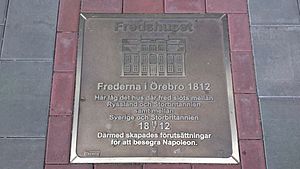Anglo-Swedish war of 1810–1812 facts for kids
Quick facts for kids The Anglo-Swedish War of 1810–1812 |
|||||||||
|---|---|---|---|---|---|---|---|---|---|
| Part of the Napoleonic Wars | |||||||||
 Memorial plate to the Treaty of Örebro |
|||||||||
|
|||||||||
| Belligerents | |||||||||
| Commanders and leaders | |||||||||
| N/A | N/A | ||||||||
| Strength | |||||||||
| N/A | N/A | ||||||||
| Casualties and losses | |||||||||
| None | None | ||||||||
During the Napoleonic Wars, Sweden and Great Britain were friends. They fought together against Napoleon until 1810. But after Sweden lost two wars, the Finnish War and the Pomeranian War, things changed. Sweden had to sign peace treaties, the Treaty of Fredrikshamn and the Treaty of Paris. Because of these treaties, Sweden was forced to declare war on Great Britain. This war, however, was mostly "on paper." No real fighting happened. Great Britain could even keep its ships at the Swedish island of Hanö. They also continued trading with countries around the Baltic Sea.
Contents
Background
The Treaty of Paris was signed on January 6, 1810. It made Sweden join the Continental System. This system was a big trade ban against Great Britain. Great Britain was Sweden's main trading partner. So, this ban caused many money problems for Sweden. People still traded with Britain, but it was done secretly through smuggling.
On November 13, 1810, France gave Sweden a strong message. France demanded that Sweden do three things within five days:
- Declare war on Great Britain.
- Take over all British ships in Swedish ports.
- Seize all British goods in Sweden.
France and its friends threatened to declare war on Sweden if it did not agree. So, on November 17, 1810, the Swedish government declared war on Great Britain.
The War
Even though war was declared, no battles or fights actually happened. Great Britain was even allowed to keep its ships on the island of Hanö. This meant Britain was "occupying" the island. Sweden did not try to stop this. Britain used Hanö to keep trading with Sweden.
There was only one sad event during this "paper war." On June 15, 1811, a Swedish general named Hampus Mörner led 140 soldiers. They went to stop a group of farmers in Klågerup in Scania. These farmers were upset about a new rule that forced young men to join the army. In these Klågerup riots, the soldiers sadly killed 30 farmers.
Aftermath
The Crown Prince of Sweden, Charles August, had passed away in May 1810. So, on August 21, 1810, a French general named Jean-Baptiste Bernadotte was chosen as the new Crown Prince of Sweden. Bernadotte was only the Crown Prince, meaning he was supposed to be under King Charles XIII. However, the King was not well and not very interested in ruling. So, Crown Prince Bernadotte became the real leader of Sweden.
Under Bernadotte's leadership, Sweden's friendship with Napoleon's France got worse. In 1812, France took over Swedish Pomerania and the island of Rügen. Because of this, Sweden decided to make peace with Great Britain.
After many talks, the Treaty of Örebro was signed on July 18, 1812. On the same day and in the same place, Great Britain and Russia also signed a peace treaty. This ended their own war, the Anglo–Russian War (1807–1812).
See Also

